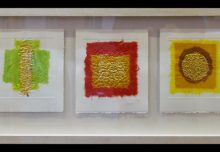Licensing art
Licensing is an important item in an artist’s tool cupboard. It does a couple of things that really make a difference. And it can sort out the amateurs from the professionals.

So what is it? Licensing is where an artist’s artwork image is used by a second party on another product. The most obvious example is when a print publisher takes the image from an original painting and produces prints that they then sell. The artist gets a royalty or fee for allowing this.
Other examples are calendars, greetings cards, table-mats, dress fabrics etc.

Some greetings cards licensed by Colin Ruffell
As I have written elsewhere this can have a nice spin off for the artist.
Firstly they get paid without having to do any more work after painting the original painting. The royalty or fee can be quite substantial sometimes.
Secondly the exposure of the image in a secondary product can make the public much more aware of the artists work. The artist becomes better known. They will sell other work better because more people will be aware they they exist.
So the artist might become both richer and more famous.
The way it works.
The artist is the licensor and his/her work is licensed under contract for use by the licensee.
A contract between the licensor and licensee would typically be,
- for a specified image
- for a set period of time,
- for an agreed specific usage
- for a specific geographic location
- for a fixed percentage or fee.
The contract should state when the artist gets paid. It might be that an up front payment is made with or without a percentage of later wholesale receipts, or it might be on a percentage of wholesale receipts only.
Most well established licensees will have a formal licensing agreement already in place, which the newbie artist will be expected to accept. It would be a good idea to talk to other artists, or get specialist legal help, before committing oneself to signing anything.
Common pitfalls are that the licensee is a bad payer, or will fail to tell the artist of all sales of the licensed image, or will commit to deals that are not in the artist’s best interest.
But there are other downsides as well.
Some people think that a reproduction print demeans the integrity of the original painting and undermines the ‘original print’ market. I don’t agree, but have to accept that traditional ‘original prints’ are less exclusive nowadays since the arrival of super high quality giclee reproductions.
Another downside is that the artist who agrees to license their work will have to stand back and hope that they get sufficient honest feedback to develop their artwork. [see my recent blog about feedback]
If you do it yourself it takes time and effort to find a company that would be interested in licensing your work from you.
And of course there is a significant record-keeping task that has to recognize that it can take ages before any return might be due from a licensee paying a royalty.
If the artist wants and agrees an up-front fee then the risk is higher for the licensee who will therefore expect to pay quite a lot less.
Agencies
Established licensing agencies exist which set out to find good deals for the artwork and share the spoils with the artist in exchange for doing the research, selling, checking and invoicing of the manufacturer.
Some of these agencies are off shoots of well-established fine art publishing companies themselves. Artists who are published by a print publisher can add to their income by agreeing that the publisher may look for other deals on the artist’s behalf. They might have contacts and credibility for art licensing that you as a freelance would never equal. But you will probably have to give them at least half of the licensing income.
Copyright issues
As you may already realise, in the UK you own the copyright of your own art. This is automatic and you don’t have to do anything to register it. But as a greater safeguard there is now a way to ensure that your copyright cannot be questioned. The Fine Art Trade Guild have established an image register that dates each artwork. [see here]
If you sell the art piece to anyone else you retain the copyright even when some one else owns the actual art-piece. When a buyer buys your pictures they do not buy the copyright as well, unless you also sell them the right to copy the art [copyright]. The copyright can only be transferred, from you to any one else, with your agreement in writing.
**********************************************************
Also see Art Biz Secrets Part One by Colin Ruffell on Amazon
And Art Biz Secrets Part Two by Colin Ruffell on Amazon




